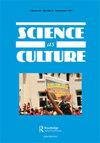Teaching the normal and the pathological: educational technologies and the material reproduction of medicine
IF 2.5
3区 哲学
Q1 CULTURAL STUDIES
引用次数: 1
Abstract
ABSTRACT That pathology and normality exist on a complex spectrum of bodily manifestation is an enduring problem at the heart of the philosophy, anthropology and history of medicine. As the primary locus for the reproduction of medicine, medical schools are important sites for cultivating knowledge of what is normal and what is not. Here students come to engage with the slippery concepts of normality and pathology in collaboration with a wide range of educational technologies – the cadavers, plastic models, illustrations and diagnostic tools which corral student knowledge of the body in both health and disease. These technologies are not universally employed across medical faculties, and variations in their use contributes to various constructions of pathology and normality. Ethnographic observation and historical research in medical faculties in Hungary, the Netherlands and Ghana, shows that educational practices are shaped by the epistemic traditions which manifest in the material environment of the medical school, and that these different sociomaterial settings contribute to inconsistent notions of normalcy. Although educational technologies often tend towards fixity in their representations of the body in health and disease, medical school practice in the north of Ghana resists the imposition of the often alien standards typically found in teaching materials imported from Europe or North America. By teaching around and beyond these materials, Ghanaian educators also challenge their assuredness and the intellectual history of contemporary medicine.师范与病理学教学:教育技术与医学物质再生产
病理学和正常性存在于一个复杂的身体表现谱中,这是哲学、人类学和医学史的核心问题。医学院作为医学繁殖的主要场所,是培养什么是正常知识和什么不是正常知识的重要场所。在这里,学生们与广泛的教育技术合作,开始接触正常和病理学的狡猾概念——尸体、塑料模型、插图和诊断工具,这些工具汇集了学生对身体健康和疾病的知识。这些技术并没有在医学院中普遍使用,它们的使用变化导致了病理学和正常化的各种结构。匈牙利、荷兰和加纳医学院的民族志观察和历史研究表明,教育实践是由医学院物质环境中表现出来的认识传统所塑造的,这些不同的社会物质环境导致了正常观念的不一致。尽管教育技术在健康和疾病方面对身体的表现往往趋于固定,但加纳北部的医学院实践抵制强加从欧洲或北美进口的教材中通常存在的外来标准。通过围绕和超越这些材料进行教学,加纳教育工作者也挑战了他们的自信和当代医学的知识史。
本文章由计算机程序翻译,如有差异,请以英文原文为准。
求助全文
约1分钟内获得全文
求助全文
来源期刊

Science As Culture
Multiple-
CiteScore
5.20
自引率
3.80%
发文量
28
期刊介绍:
Our culture is a scientific one, defining what is natural and what is rational. Its values can be seen in what are sought out as facts and made as artefacts, what are designed as processes and products, and what are forged as weapons and filmed as wonders. In our daily experience, power is exercised through expertise, e.g. in science, technology and medicine. Science as Culture explores how all these shape the values which contend for influence over the wider society. Science mediates our cultural experience. It increasingly defines what it is to be a person, through genetics, medicine and information technology. Its values get embodied and naturalized in concepts, techniques, research priorities, gadgets and advertising. Many films, artworks and novels express popular concerns about these developments. In a society where icons of progress are drawn from science, technology and medicine, they are either celebrated or demonised. Often their progress is feared as ’unnatural’, while their critics are labelled ’irrational’. Public concerns are rebuffed by ostensibly value-neutral experts and positivist polemics. Yet the culture of science is open to study like any other culture. Cultural studies analyses the role of expertise throughout society. Many journals address the history, philosophy and social studies of science, its popularisation, and the public understanding of society.
 求助内容:
求助内容: 应助结果提醒方式:
应助结果提醒方式:


